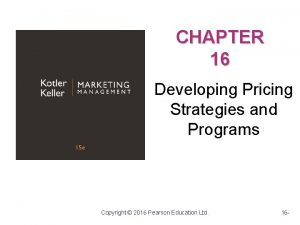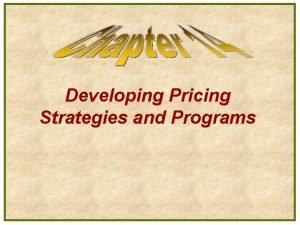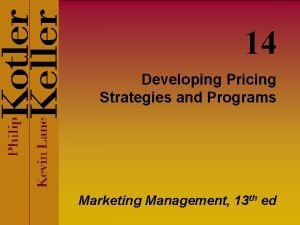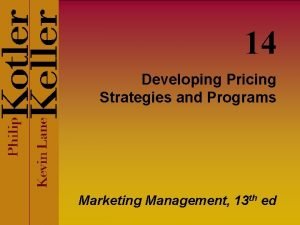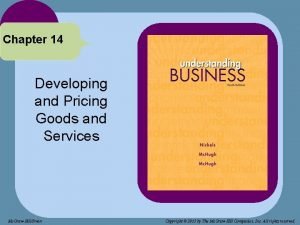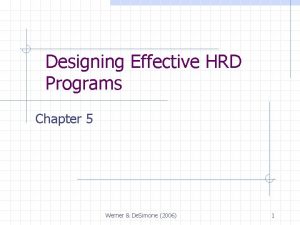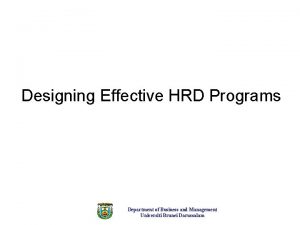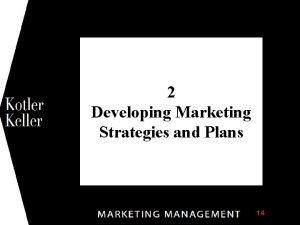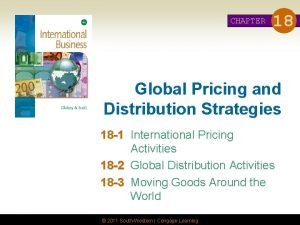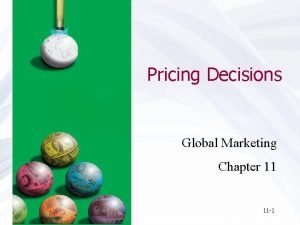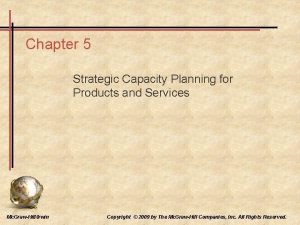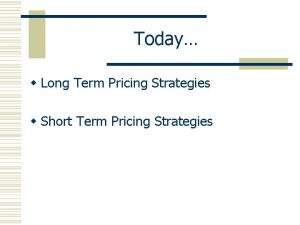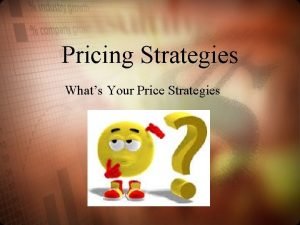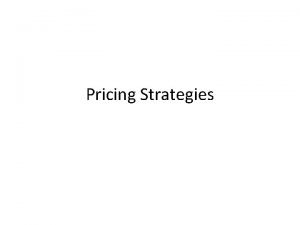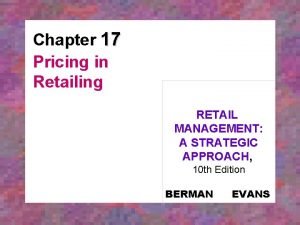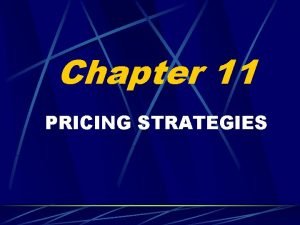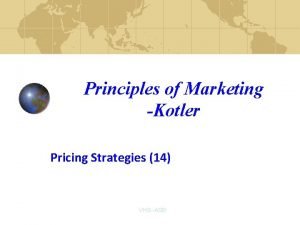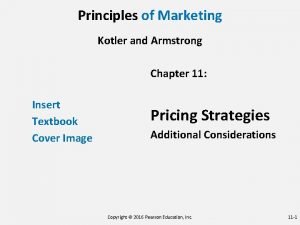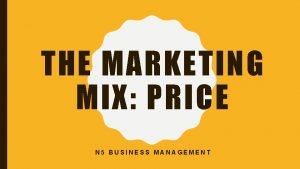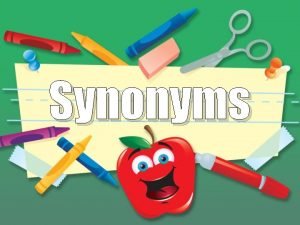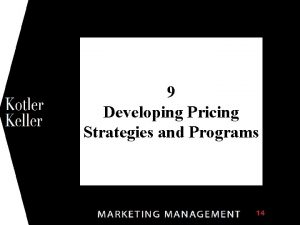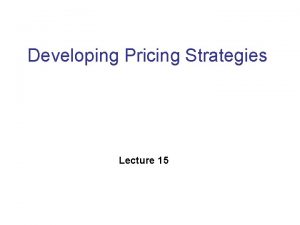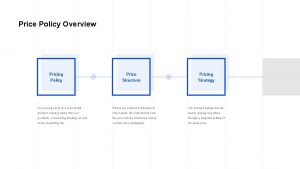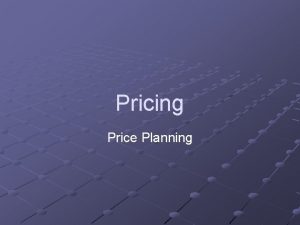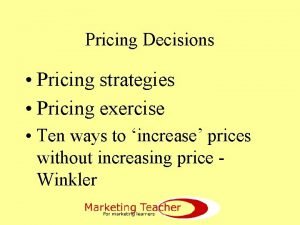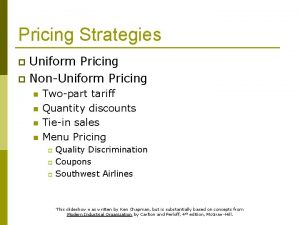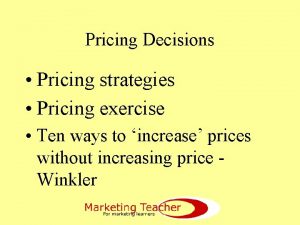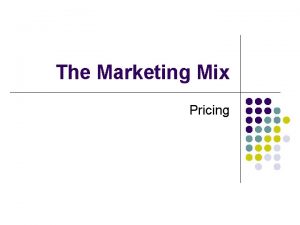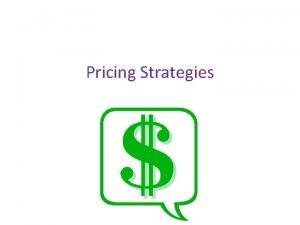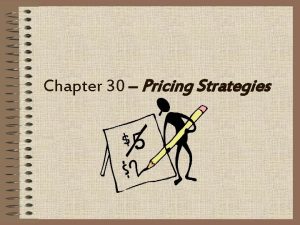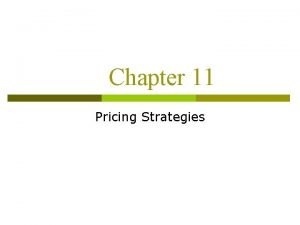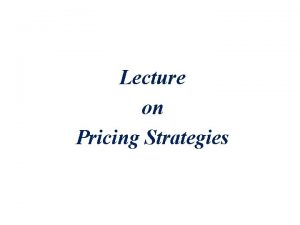Developing Pricing Strategies and Programs Synonyms for Price






























- Slides: 30

Developing Pricing Strategies and Programs

Synonyms for Price • • Rent Tuition Fee Fare Rate Toll Premium Honorarium • • Special assessment Bribe Dues Salary Commission Wage Tax

The Internet Changes the Pricing Environment By Providing Information Buyers • Get Instant price comparison from thousands of vendors • Name their price and have it met • Get products free Sellers • Monitor customer behaviour and tailors offers to an individual • Give certain customers access to special prices Both Buyers and Sellers Negotiate price in online auctions

Common Pricing Mistakes • Determine costs and take traditional industry margins • Failure to revise price to capitalize on market changes • Setting price independently of the rest of the marketing mix • Failure to vary price by product item, market segment, distribution channels, and purchase occasion

Consumer Psychology and Pricing • Reference Prices: Pricing information a consumer retains in memory that is used to interpret and evaluate a new price • Price-quality inferences: Many consumers use price as an indicator of quality. • Price endings: Sellers believe price end in odd number. • Price cues: Any marketing tactic used to persuade customers that prices offer good value compared to competitors' prices, past prices or future prices.

Steps in Setting Price • • • Select the price objective Determine demand Estimate costs Analyze competitor price mix Select pricing method Select final price

Step 1: Selecting the Pricing Objective • Survival: Short term strategy to overcome overcapacity, intense competition, or changing consumer wants Objective should be to cover all variable costs and if possible some fixed costs • Maximize Current Profit: cash flow or return on investment • Maximum Market Share: (market-penetration pricing) – Assuming high price sensitivity, firms will lower price which should precipitate a dramatic increase in volume.

Step 1: Selecting the Pricing Objective • Market Skimming - appeals to high-end market segments, early adopter segments especially in rapidly changing technology markets (e. g. phones, tablets). Prices start high and drop lower over time. Good strategy when: – A sufficient number of buyers have a high current demand – Unit costs of producing a small volume are not so high that they cancel the advantage of charging what the market will bear

Step 1: Selecting the Pricing Objective – Initial high price does not attract competitors – High price communicates the image of a superior product • Product-Quality Leadership - premium quality connotes premium price

Step 2: Determining Demand Price Sensitivity - some characteristics associated with decreased price sensitivity ‒ Customers are less sensitive to low-cost items or items purchased infrequently ‒ Seller can charge a higher price than competitors if customers are convinced it offers a lower total cost of ownership (TCO) ‒ Internet has potential to increase price sensitivity but must also target non-price-sensitive consumers as well as to not leave “money on the table”

Factors Leading to Less Price Sensitivity • • • The product is more distinctive Buyers are less aware of substitutes Buyers cannot easily compare the quality of substitutes Expenditure is a smaller part of buyer’s total income Expenditure is small compared to the total cost Part of the cost is paid by another party Product is used with previously purchased assets Product is assumed to have high quality and prestige Buyers cannot store the product

Step 2: Determining Demand Estimating Demand Curves – several different methods of measurements – Conduct surveys – information somewhat subjective – Experiment by changing prices for same product without alienating consumers or violating regulatory requirements – Statistically analyze past prices, quantities sold and other factors to gain understanding of price/demand relationships

Step 2: Determining Demand • Price elasticity of demand – Determination of the affect of a change in price on overall demand – If demand changes considerably with a change in price, it is elastic. If demand does not change significantly or in parallel with the price, it is inelastic – Long-run price elasticity – buyers continue to purchase from current supplier after a price increase but eventually switch suppliers.

Step 3: Estimating Costs • Types of Costs and Levels of Production fixed, variable, total, and average costs – To price intelligently, companies need to know its costs with different levels of production – To estimate the real profitability of selling to different types of retailers or customers, firms should use activity-basedcost (ABC) accounting instead of standard cost accounting

Step 3: Estimating Costs • Accumulated Production –Average cost falls with accumulated production experience also referred to as experience curve or learning curve –Experience-curve pricing can be risky because aggressive pricing might create a cheap image –Advantages from experience curve may lead to expansion which is a risk if there is a major technology improvement which eliminates competitive advantage and passes the advantage to other firms who adopt new technology rendering current technology obsolete

Step 3: Estimating Costs • Target costing - determine price that must be charged according to market research

Analyzing Competitor’s Costs

Step 5: Selecting a Pricing Method • Markup pricing: Standard mark-up, but can vary according to product categories. Markup price = unit cost / (1 – desired return on sales) • Target return pricing: To make a fair return on investment. Targetreturn-price = unit cost/(desired return X invested capital)/unit sales.

Step 5: Selecting a Pricing Method • Perceived value pricing - based on buyer perceptions. Many firms are now adopting this approach. • Value pricing – fairly low price for a high quality offering – Everyday low pricing (EDLP), no promotions and no change to price. This eliminates week-to-week price uncertainty. The reason firms have adopted this price strategy is that constant sales and promotions are costly and have eroded consumer confidence in everyday shelf prices. – High-low pricing – Charge higher prices on an everyday basis but run frequent promotions with prices temporarily lower than the EDLP level.

Step 5: Selecting a Pricing Method • Going rate pricing - base price on that of competitors (“follow the leader”)

Auction-Type Pricing Must qualify supplier pool before using price/cost as major decision variable in B 2 B situations. English auction - ascending bids with one seller and many buyers Dutch auctions (descending bids) – two types Auctioneer announces a high price for a product and then lowers the price until a bidder accepts Buyers announce something they want to buy and potential sellers compete to offer the lowest price Sealed-bid auctions – would-be suppliers submit only one bid and do not know the contents of the other bids. The government uses this method frequently to secure goods and services.

Step 6: Selecting the Final Price • The influence of other marketing activities brand’s quality and advertising relative to the competition (know brands with high quality and high relative advertising can command higher prices) • The influence of other marketing-mix elements - note relationships between relative price, relative quality, and relative advertising

Step 6: Selecting the Final Price • Company pricing policies - contemplated price must be consistent • Gain-and-risk sharing pricing - risk losing customers if cannot deliver full promised value • Impact of price on other parties distributors, sales force, competitors, suppliers, government, etc.

Thank you

Geographical Pricing • Pricing varies by location

Price Discounts and Allowances • • • Discount Quantity discount Functional discount Seasonal discount Allowance

Promotional Pricing Tactics • • Loss-leader pricing Special-event pricing Cash rebates Low-interest financing Longer payment terms Warranties and service contracts Psychological discounting

Differentiated Pricing • • Customer-segment pricing Product-form pricing Image pricing Channel pricing Location pricing Time pricing Yield pricing

Methods for Increasing Prices • • Delayed quotation pricing Escalator clauses Unbundling Reduction of discounts

Brand Leader Responses to Competitive Price Cuts • • • Maintain price and add value Reduce price Increase price and improve quality Launch a low-price fighter line
 Developing price strategies and programs
Developing price strategies and programs Developing pricing strategies and programs
Developing pricing strategies and programs Developing pricing strategies and programs
Developing pricing strategies and programs Developing pricing strategies and programs
Developing pricing strategies and programs Ano ang ibig sabihin ng shortage sa pamilihan
Ano ang ibig sabihin ng shortage sa pamilihan Developing and pricing goods and services
Developing and pricing goods and services Designing and developing effective hrd programs
Designing and developing effective hrd programs Designing and developing effective hrd programs
Designing and developing effective hrd programs The marketing plan the central instrument
The marketing plan the central instrument Developing marketing strategies and plans
Developing marketing strategies and plans The marketing plan the central instrument
The marketing plan the central instrument Collection of programs written to service other programs.
Collection of programs written to service other programs. Pricing and distribution
Pricing and distribution Global pricing objectives and strategies
Global pricing objectives and strategies Facile counting
Facile counting Dr luke harvey
Dr luke harvey Strategic capacity planning for products and services
Strategic capacity planning for products and services Strategies for developing loyalty bonds with customers
Strategies for developing loyalty bonds with customers Short term pricing strategies
Short term pricing strategies Product mix pricing strategy
Product mix pricing strategy Chapter 26 pricing strategies answer key
Chapter 26 pricing strategies answer key Differential pricing strategy
Differential pricing strategy Pricing strategies in retail management
Pricing strategies in retail management Segmented pricing
Segmented pricing Retail pricing management
Retail pricing management Kotler pricing strategy
Kotler pricing strategy Example of captive product pricing
Example of captive product pricing Chapter 26 pricing strategies
Chapter 26 pricing strategies 5 marketing mix
5 marketing mix Managing and pricing deposit services
Managing and pricing deposit services Pricing strategies of starbucks
Pricing strategies of starbucks
